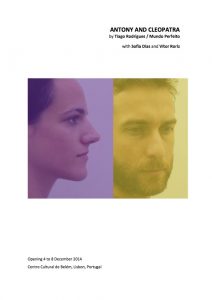About This Clip
Antony and Cleopatra
Two Portuguese choreographers – Vítor Ruiz and Sofia Dias – were chosen to impersonate Antony and Cleopatra in this adaptation, in which Tiago Rodrigues creates his own text, borrowing freely from Shakespeare’s play and Plutarch’s Parallel Lives. In this show, both actors are on stage: Sofia describes Antony’s behavior, while Vítor characterizes Cleopatra, their lines representing what each character sees, says and does, so that what is usually left off stage – the text’s didascalia – has here been integrated into the text. Likewise, characters’ feelings and emotions are not represented in each actor’s way of acting, but exteriorized through language, which means that any correspondence between words and physical behavior is denied. This aspect of the performance is slightly evocative of Mind Out, a show by the English company Station House Opera. But in Antony and Cleopatra stage directions do not lead to actions – they simply describe what is happening. Although the actors’ movements on stage are sometimes literalized, as happens at the beginning of the show, they do not usually represent particular words or events and are rather a way of dancing in which dancing is not required. Perhaps the scene that best illustrates the relation between words and movement occurs at the ending, in which words are rapidly transformed into other words in a sequence of sounds which, in Portuguese, distort each other (“tosse, tosse, má tosse, má tosse, matou-se, matou-se, meu doce”). This language game would require a good translation so that the alliteration could be preserved, something like “he coughed, coughed, was killed, killed, my kindred, kindred, kindred spirit”, and so on. While this happens, both actors are on opposite sides of the stage, fighting until they finally approach each other to die. Unlike what happens in Shakespeare’s plays, in which the final act takes place quickly, Antony and Cleopatra take their time to die, repeating each other’s name and portraying each other’s breath / death while the light slowly fades. To quote from the program notes: “That’s the idea that Plutarch himself proposes when, in the passage where he describes the way Antony flees the battle to pursue Cleopatra, he writes in a jocular but understanding tone that ‘the soul of a lover always lives in someone else’s body’”.
Cast and Crew
Text: Tiago Rodrigues with quotes from William Shakespeare’s Antony and Cleopatra (translated by Rui Carvalho Homem).
Performers: Sofia Dias and Vítor Roriz.
Set design: Ângela Rocha.
Costumes: Ângela Rocha and Magda Bizarro.
Music: excerpts from the soundtrack of the movie “Cleopatra” (1963), composed by Alex North.
Light Design: Nuno Meira.
Sound: Miguel Lima and Sérgio Milhano.
Artistic Collaboration: Maria João Serrão and Thomas Walgrave.
Technical Support: Amarílis Felizes
Mobile. Construction: Decor Galamba.
Production Manager and Photographer: Magda Bizarro.
Executive Producer: Rita Mendes.
Production: Mundo Perfeito.
Production notes provided by Maria Sequeira Mendes, Assistant Professor, School of Arts and Humanities – University of Lisbon.
Antony and Cleopatra
Related Productions
- Antony and Cleopatra (Doran, Gregory; 2006)
- Antony and Cleopatra (2011) (Ninagawa, Yukio; 2011)





